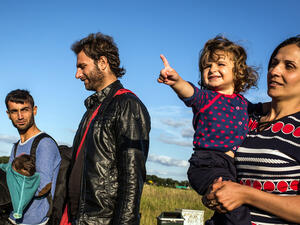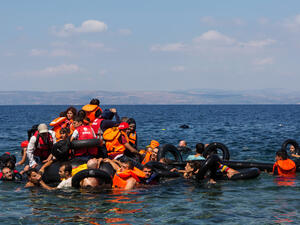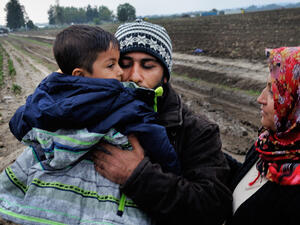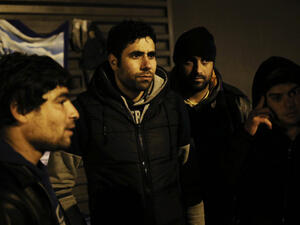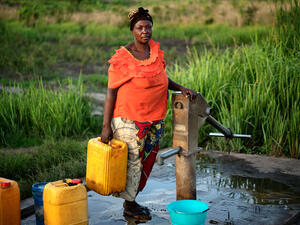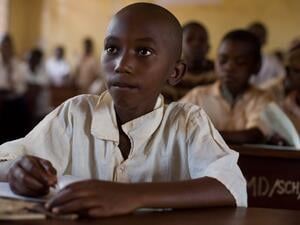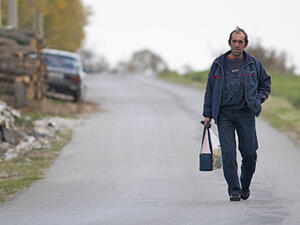Hundreds of new flats honour pledge of refugee integration in Serbia
Hundreds of new flats honour pledge of refugee integration in Serbia

The Zivkovic family, one of the refugee families that has received a flat under the local integration programme in Serbia.
PETROVAC, Serbia, 2 August (UNHCR) - The smiling faces of Nina, Damir and son Neven Orlic showing their contract on the new apartment in Krajiska Street in Petrovac, Serbia reveal their happiness.
With their voices echoing from the bare, painted walls and ceramic tiles of their new 35 square metre apartment, they relate plans to furnish it and surprise their daughter Nikita, a member of the Serbian volleyball team abroad preparation for the next championship. The new flat is the dream-come-true for the Orlics, who arrived in Petrovac 12 years ago from Knin, Croatia.
Their next door neighbour is the Zivkovic family from Vrginmost, also in Croatia. When they first arrived in 1996, Svjetlana and Sveta had a baby daughter, Mirjana. Milena was born the following year. And two years ago the girls got twin brothers, Djoko and Stefan.
With four children, Zivkovic family was entitled to a larger flat in a new 44-apartment building constructed by the German humanitarian NGO HELP, funded by the EC and managed by the European Agency for Reconstruction (EAR).
The apartment building in Petrovac, which opened on 5 July, is one in a line of similar activities implemented by HELP. Days before, a similar building with 23 flats was handed over to refugee families in Obrenovac, near the capital Belgrade.
In addition to providing housing for refugee and vulnerable families, HELP has focused on improving economic activities. The organisation received funding of over €1.5 million for two years by EC/EAR to implement activities under the project, which was entitled "Supporting the National Strategy for Resolving the Problems of Refugees and IDPs through Support for Individual Living and Livelihood Enhancement".
With a new power saw and other basic equipment worth €1,200 donated by HELP, Svjetlana and Sveta Zivkovic can not only make their own furniture for the new flat but assist their neighbours and significantly enhance their family budget.
The two-storey building was built on a plot donated, along with the infrastructure, by the municipality of Petrovac. Assistance was provided by the Serbian Commissioner for Refugees under the system established when the UN refugee agency first started implementing programmes for refugee integration in Serbia in 1997. Ever since, and with the help of various donors, thousands of refugees from Croatia and Bosnia and Herzegovina who chose to integrate in Serbia received new housing, along with business opportunities that helped them become economically self-sufficient.
The work of international organizations to solve the housing problem, a main obstacle to refugee integration in Serbia, has helped reduce the number of collective accommodation centres. The number fell from over 400 centres hosting more than 29,000 refugees in 2001, to 67 centres with 6,700 beneficiaries in 2007, the majority of them people displaced from Kosovo.
With plans currently underway for up to 800 apartments to be handed to integrated refugees and other vulnerable population by the end of this year, Serbia will take a major step to achieving goals set by the Sarajevo Declaration signed in January 2005.
With assistance from UNHCR, OSCE and EU, the representatives of governments from Croatia, Bosnia and Herzegovina, Montenegro and Serbia made a commitment to help remove all obstacles in the way of return and integration of refugees in the region. The time frame to achieve that and close the refugee saga was originally the end of 2006, but it took much longer.
Serbia hosts nearly 300,000 refugees and internally displaced persons - the biggest number of such people in the region. For most, after 12 years of living here the preferred solution is integration. The hundreds of new flats being built by international and local organizations in Serbia this season will bring that promise of the Sarajevo Declaration closer.
By Vesna Petkovic in Petrovac, Serbia


